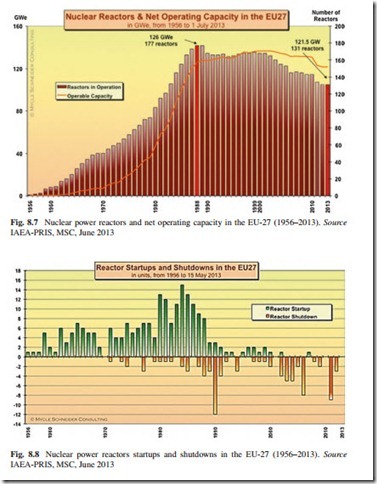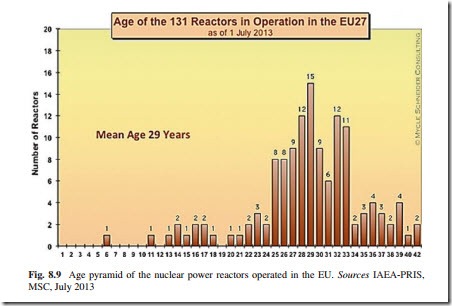The Future Contribution of Nuclear Energy to the Electricity Generation in the European Region
The EU-27 has gone through three nuclear construction waves, two small ones in the 1960s and 1970s, plus a large one in the 1980s (mainly in France). The region has not had any significant building activity since the 1990s. In July 2013, 14 of 27 countries in the enlarged EU operated 131 nuclear power reactors—about one-third of the world total—12 fewer than before the Fukushima Daiichi nuclear accident and one-quarter below the historic maximum of 177 units in 1989 (see Fig. 8.7) The vast majority of the facilities, 112 or 85.5 %, are located in eight of the Western countries, and only 19 are in the six newer EU member states with a nuclear power program (Schneider et al. 2014).
In 2012, nuclear power produced 27 % of the commercial electricity in the EU, down from 31 % in 2003 (Eurelectric 2013). Nearly half (48 %) of the nuclear electricity in the EU-27 was generated by one country: France.
Figure 8.8 shows the number of nuclear power reactors startups and shutdowns in the EU-27 during the period 1956–2013.
With the lack of new nuclear power reactor construction, the average age of the EU’s reactors now stands at 29 years (see Fig. 8.9).
The projections of nuclear-generating capacity until 2030 show that some 160 nuclear power reactors globally could be shutdown in the next ten years on the basis of their original design lifetime. Without life extensions, nuclear capacity would thus fall dramatically in the next decade, especially if the construction of new nuclear power plants also slows as a result of the Fukushima Daiichi nuclear accident (OECD 2012).
When the future contribution of nuclear energy in the electricity production in the European region is analyzed, the following elements should be taken into consideration:
• Nuclear technology has reached its majority age and it is a safe and non-pollutant of the environment. In 2014, a total of 30 countries (31 countries if Taiwan is considered outside China) were using nuclear energy for electricity production, 17 of them in the European region;
• The supply of fossil fuels could not be enough to support the growing energy needs of many European countries for the second half of this century;
• A safety nuclear culture has been developed at world level, elevating the safety
of the current nuclear power reactors in operation;
• A new generation of nuclear power reactors (Generation IV) will be available in the coming decades with increase safety features and with less construction time;
• The appropriate technologies exist for the safe treatment and for the final disposal of the high-level radioactive nuclear waste.
The acceptance by the public opinion of Finland and Sweden of the final disposal of high-level radioactive nuclear waste in their countries and the technological advances reached by the USA on this important subject, allows a little bit more optimistic view about the future of nuclear energy for electricity production in the European region. However, according to the IAEA Nuclear Technology Review of 2006, “no final high-level waste repositories are expected to be in operation much before 2020.”
It is important to note, when considering the future role to be played by nuclear energy in the energy balance in the European region, the following situation: Nearly 30 % of Europe’s generating capacity is now more than 30 years old. The oldest installations are hydroelectric. Following these in age are coal-fired power plants, most of which date from the 1960s to 1990s. In the 1970s, nuclear power started up, reaching a peak between 1980 and 1990, followed by a period during which development was halted. From the 1990s onwards, natural gas and renewables became more important. Renewable resources (mainly wind energy) have become especially popular over the last decade in several countries within the European region.
From the above paragraph can be clearly stated that coal and nuclear power plants account for more than 70 % of all power plants that will be at least 30 years old in 2020. Replacement of more than 50 % of the current electrical installations must be addressed as early as possible. The question of replacing capacity will first affect coal combustion and later nuclear energy. Specifically, replacing the coal power plant capacity with cleaner forms of power generation will probably bring economic advantages. Alternatives to replace include termination of production, extension of operating licenses, or radical renovation.

